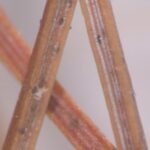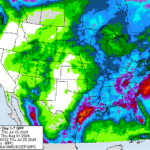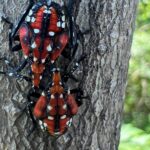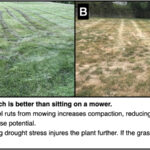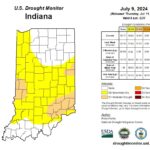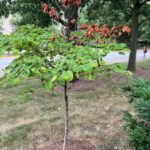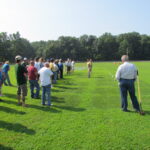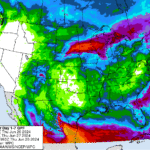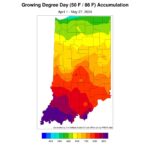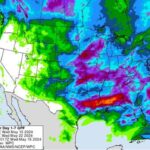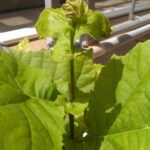Early June, we received a white pine sample at the Purdue University Plant and Pest Diagnostic Lab that showed early season needle loss lower in the tree canopy (Figure 1, 2). The majority of conifers hold onto their needles for multiple years, so loss of needles, even in the fall, can come as a shock[Read More…]
Resources for landscapes and gardens in the Midwest
Found 520 Articles
Several weeks ago, Indiana received enough rain to eliminate drought across the state, leaving behind just a few counties in Abnormally Dry (D0) status. Fortunately, this week has been relatively quiet, allowing many areas to alleviate flooding issues. The U.S. Drought Monitor kept those Abnormally Dry areas nearly the same this week (Figure 1), so[Read More…]
Bill Walton, the legendary basketball player, sports announcer and perhaps the most outspoken and famous Grateful Dead fan, passed away in May leaving behind enough quirky quotes and euphemisms to make Yogi Berra proud. In a now viral clip since his passing, Mr. Walton reflects on teachings from his legendary coach and former Purdue basketball[Read More…]
The remnants of Hurricane Beryl brought much-needed rain to the state, although some areas experienced excessive totals. In addition, sporadic power outages were reported as a result of wind gusts exceeding 30 mph. The Community Collaborative Rain, Hail, and Snow (CoCoRaHS) volunteer network once again proved essential, with observations ranging from just under 0.4 inches[Read More…]
With recent rain storms across the state, watering may not be at the forefront of everyone’s minds. But as we head deeper into summer it is food to remember most of Indiana is in a state of abnormal dryness to moderate drought, continuing similar conditions from previous years. With that in mind, we should be[Read More…]
Join the Turf Specialists for Lawn Care Diagnostic Training on August 1, 2024. Click here to register “The Purdue Turfgrass Program created Diagnostic Training Events in 2011 to provide turf industry professionals the opportunity to learn in a hands-on, demonstration fashion. Participants will learn concepts through presentations in the classroom and in the field during[Read More…]
Recently a homeowner in Hamilton County posted on the Indiana Native Plant Society Facebook page with concerns about aphids, mites, and apple scab in her maple and oak trees. She asked for a second opinion and treatment options for these pests. I reached out to the homeowner and requested permission to collect samples from the[Read More…]
As I write this article, in a cool, air-conditioned office, I hear others talking about how hot it is outside. I see weather app icons showing bold suns that stress how sunny and hot conditions are and will continue to be. I read Special Weather Statements, issued by the National Weather Service, about an extended[Read More…]
The past two months have been relatively wet and cool to warm. This prolonged period of overcast conditions, high humidity, and light to moderate rainfall is perfect for some of our foliar disease issues. “April flowers bring May Leaf spots” doesn’t have the right ring to it, but we are seeing quite a bit of[Read More…]
As of writing, it appears we’re heading into the start of meteorological summer (June 1) with a wet meteorological spring on the books. Meteorological spring will end with over 15 inches of rain from March 1 through the end of May, making it the 24th wettest Spring on record for Indianapolis. Keep in mind, records[Read More…]
Allergy season is in full swing. At least, it is for me. Runny nose, itchy eyes, and consistent drainage that I have to clear in the shower every morning. We love spring, right?? That’s enough complaining for now. Indiana’s April 2024 average temperature was 55.1°F (3°F above normal), which was good enough for 14th warmest[Read More…]
A recent conversation with a landscaper about tank mixing led to a brief discussion about glyphosate products with a contact herbicide included. I thought I would share my thoughts on the addition of contact herbicides and its effectiveness on weed control. We all know that we live in a microwave society. Most people want things[Read More…]
The Purdue Turf and Landscape Field Day is an annual one-day event with the objective of providing professional turf and landscape managers exposure to research and educational opportunities with the latest research results and technical resources. The Field Day features research tours, talks on current topics, and a tradeshow with over 40 exhibitors displaying equipment[Read More…]
Most people these days have, at the very least, heard of Callery and Bradford pear trees and know something about the invasiveness of this ornamental street tree. But I still get questions about what it is and why it’s so bad. So, I’d like to offer a little history of this infamous tree. Where did[Read More…]
Rocky Mountain juniper, Juniperus scopulorum, has gained some popularity in Midwest landscapes due to cold and drought tolerance, and to the availability of several upright columnar varieties with attractive blue color, including ‘Skyrocket’ and ‘Wichita Blue’. Like many other junipers, J. scopulorum may suffer dieback of small branches and twigs caused by the fungal pathogens[Read More…]
It’s gonna be… I mean… it’s already May! How can this be? Early spring flowers have already cycled through, I’m on record pace for mowing my yard, and field activity has been delayed due to a wet April. April began a bit cool with several mornings having frost advisories and freeze warnings, which was not[Read More…]
Identifying a plant problem is the first step to improve the health of plants in the landscape. We created a series of short (5 to 7 min) YouTube videos to help you learn or just brush up your plant diagnostic skills. Each video guides you through the diagnostic process in real landscapes, reviews pest biology[Read More…]
Identificar qué problema tiene la planta es el primer paso para mejorar la salud de las plantas en el jardín. Hemos creado una serie de videos cortos (5 a 7 minutos de duración) en YouTube. Esto lo hemos hecho para ayudarlo a aprender o simplemente mejorar sus habilidades de diagnóstico de plantas. Cada video te[Read More…]
It is the policy of the Purdue University that all persons have equal opportunity and access to its educational programs, services, activities, and facilities without regard to race, religion, color, sex, age, national origin or ancestry, marital status, parental status, sexual orientation, disability or status as a veteran. Purdue is an Affirmative Action Institution. This material may be available in alternative formats. 1-888-EXT-INFO Disclaimer: Reference to products in this publication is not intended to be an endorsement to the exclusion of others which may have similar uses. Any person using products listed in this publication assumes full responsibility for their use in accordance with current directions of the manufacturer.
Sign-up to receive email news and alerts from Purdue Landscape Working Group:
